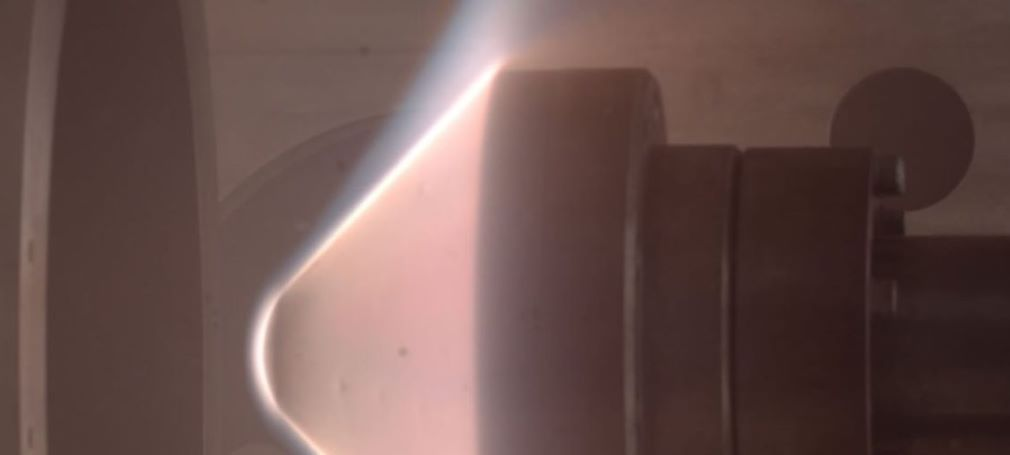Speaker
Description
Background of the study:
This work demonstrates a versatile optical system capable of providing simultaneous radiation measurements from the vacuum ultraviolet (VUV) to the mid-wave infrared (MWIR). The system consists of several easily swapable configurations that aim to not only minimise experimental setup and alignment time but also increase the scientific output of the X2 expansion tube facility.
In experimental facilities studying shock layer radiation, measurements are commonly obtained using emission spectroscopy. The simplest optical configuration required for these measurements is based on the thin lens equation, in which the system properties, such as magnification and total system length, are fixed by the selection of just three variables: the lens focal length (f), distance from the object to the lens (u), and the distance from the lens to the image (v). Despite the formulation using lenses, facilities typically implement focusing mirrors instead to limit optical aberrations. In practice several additional optical components such as flat mirrors and periscopes are also required to overcome spatial restraints and to provide the desired image orientation. For a facility that specialises in radiation measurements over models, such as the X2 expansion tube, a given experiment’s field of view requirements can range anywhere from 1 mm to upwards of 50 mm. This often necessitates custom optical setups for each campaign, which in turn results in further facility downtime as new systems are installed, aligned, and calibrated. Not only does this downtime reduce the scientific output of the facility but, for the study of shock layer radiation, the lengthy setup time and associated complexity often limits the implementation of additional optical systems that could be used to obtain measurements over a larger range of wavelengths.
In choosing to instead base an optical system on a two-lens combination system, the relative simplicity of a one lens system is sacrificed in favour of the increased flexibility that the additional variables offer to the design space. This flexibility enables the design of an optical system in which the relative positions of all optical components are fixed, and instead system magnification can be altered by simply swapping between different combinations of the two focal mirrors.
To extend the versatility of this optical system dichroic mirrors have also been implemented. These operate by splitting the incoming light by wavelength region with minimal loss in signal intensity. If placed near the focal plane of the two-lens optical system, these mirrors subsequently allow for light from a single optical path to be split and sent into a series of spectrographs. This has been implemented on the X2 facility to provide simultaneous radiation measurements from the VUV to MWIR along the same line-of-sight for up to four spectral regions at a time.
Methodology:
In contrast to a traditional one lens optical setup, when approaching the additional design variables required for a two-lens system the larger parameter space can be more difficult to optimise. To alleviate this, several constraints were introduced to the system design process in the hope of an optical system that offers a range of magnifications predominantly controlled by modifying the focal lengths of the two main mirrors in lieu of large changes to mirror positions. However, whilst custom focal length mirrors allow for a fully fixed optical configuration, in practice this would require many custom mirrors which could be cost prohibitive. As such, the first constraint implemented for the primary optical system was that the focal mirrors had to be standard focal lengths that were commercially available. Subsequent constraints involved limiting total system length based on the available space and ensuring all angles between mirrors were kept as small as possible to limit optical aberrations such as astigmatism. The problem was approached iteratively, with an algorithm designed to sort through the given constraints and output viable systems that covered a wide range of magnifications whilst sharing similar optical layouts. For each system that satisfied the constraints a series of radiation measurements were undertaken using the X2 facility to test and showcase each optical configuration.
Results:
An optical layout was chosen to enable four easily interchangeable configurations, allowing for the study of radiation in X2 along 5, 8, 13, and 50 mm long fields of view with minimal changes to optical layout. Tests are currently underway using the X2 facility to test each configuration, providing radiation data from the VUV up to MWIR for a range of planetary entries. Analysis of the system and the resulting radiation data for the case of a high-speed Earth re-entry will be presented during the conference.
Conclusion:
A robust optical system was developed that enabled the study of radiation over flow scales ranging from 5 to 50 mm by utilising a two-focal mirror system to minimise large changes in mirror and spectrograph placement. This was paired with a set of dichroic mirrors to provide radiation measurements at these length scales for the case of a high-speed Earth re-entry simultaneously from the VUV to the MWIR spectral regions.
Summary
A robust optical system was developed that enabled the study of radiation over flow scales ranging from 5 to 50 mm by utilising a two-focal mirror system to minimise large changes in mirror and spectrograph placement. This was paired with a set of dichroic mirrors to provide radiation measurements at these length scales for the case of a high-speed Earth re-entry simultaneously from the VUV to the nIR spectral regions.

